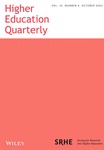‘Marketization’ of higher education in Peru: Who attends private institutions and what are the perceived advantages (disadvantages)?
| Year | : | 2022 |
|---|---|---|
| Author/s | : | Amrit Thapa, Alejandra Miranda, Alan Sanchez, Jere R. Behrman |
| Area/s | : | Education and learning |
Thapa, A., Miranda, A., Sánchez, A. & Behrman. J. R. (2022) ‘Marketization’ of higher education in Peru: Who attends private institutions and what are the perceived advantages (disadvantages)?, Higher Education Quarterly.
Debate continues on the effects of the global proliferation of private higher-educational institutions, especially for-profit institutions. The authors examine two related questions for Peru using mixed methods: Who attends private institutions and what are their perceived advantages/disadvantages? Longitudinal quantitative data suggest higher-educational segmentation starting early in life, whereby young people from wealthier households attended private institutions and those from poorer households attended public ones. Interviews with teachers, students, and staff provide insights on perceived strengths and drawbacks of higher-educational marketization and highlight the importance of family background in higher-educational choices, governmental regulation, and close monitoring of higher-educational quality.







